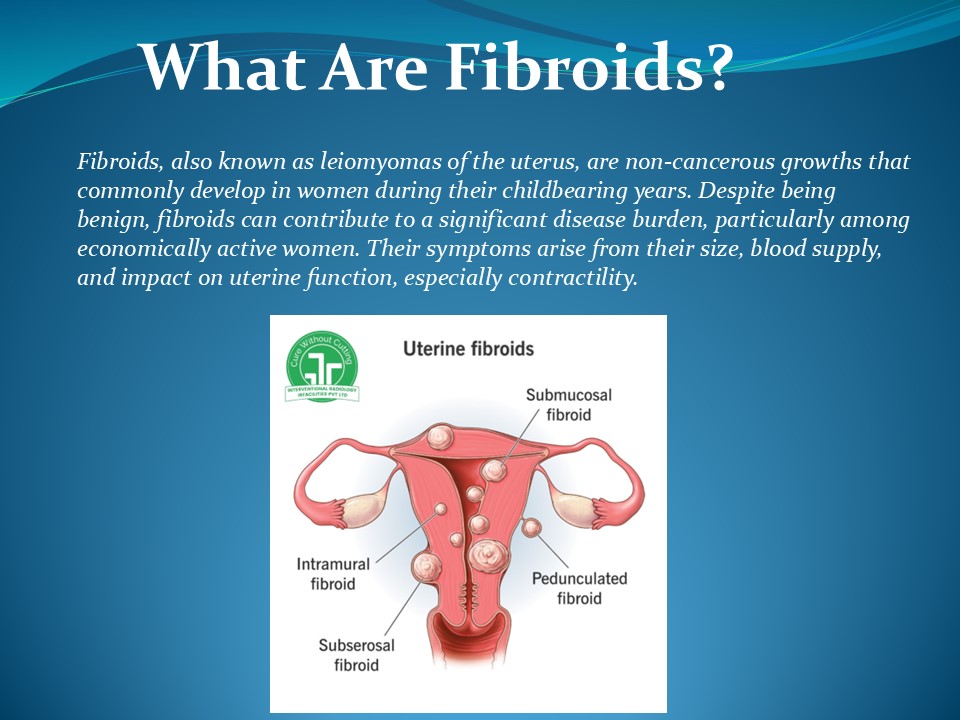Uterine Fibroid Embolization - PowerPoint PPT Presentation
Title:
Uterine Fibroid Embolization
Description:
Uterine Fibroid Embolization (UFE) is a minimally invasive procedure used to treat fibroids. Through a small pinprick, a catheter is inserted into the uterine artery. We then release small particles, called polyvinyl alcohol (PVA) particles, which block the blood supply to the fibroids, causing them to shrink. – PowerPoint PPT presentation
Number of Views:0
Title: Uterine Fibroid Embolization
1
What Are Fibroids?
Fibroids, also known as leiomyomas of the uterus,
are non-cancerous growths that commonly develop
in women during their childbearing years. Despite
being benign, fibroids can contribute to a
significant disease burden, particularly among
economically active women. Their symptoms arise
from their size, blood supply, and impact on
uterine function, especially contractility.
2
The primary symptoms of uterine fibroids include
- Bladder pressure As fibroids enlarge, they may
press against the bladder, causing symptoms like
frequent urination. - 2. Heavy menstrual bleeding The increased
vascularity of fibroids can lead to excessive
bleeding during menstruation. - 3. Menstrual pain Fibroids can affect the
uterine contractility, leading to painful
menstrual cramps. - Despite their non-cancerous nature, these
symptoms can significantly impact a womans
quality of life and may necessitate treatment
depending on the severity.
3
Incidence of Uterine Fibroid Embolisation (UFE)
The incidence of uterine fibroids varies across
different populations and demographics, but it is
recognized as one of the most common uterine
tumors. Despite their prevalence, fibroids are
almost always benign. Studies suggest that
fibroids can affect anywhere from 25 to 70 of
women at some point in their lives.
4
UFE in comparison to other surgical methods of
treatment
Traditionally, uterine fibroids have been treated
through various surgical methods, the most common
and invasive being hysterectomy, which involves
the complete removal of the uterus. This ancient
approach has long been the default for managing
severe fibroid symptoms. Hysterectomy can be
performed through different methods, including
trans-abdominal, trans-vaginal, or laparoscopic
procedures. However, all of these approaches
result in the partial or total removal of the
uterus.
5
In stark contrast, Uterine Fibroid Embolization
(UFE) offers a non-surgical, uterus-sparing
alternative. Instead of removing the fibroid or
uterus, UFE works by blocking the blood supply to
the fibroid. During the procedure, a tiny
pinprick is made in the groin, and a catheter is
inserted into the uterine arteries. Small
particles called BVA particles are injected to
block the blood flow to the fibroids, causing
them to shrink over time. This innovative
treatment preserves the uterus, offering women a
minimally invasive option that avoids the trauma
and long recovery associated with surgery.
6
Success Rate of UFE
It sounds like youre explaining the process of
Uterine Fibroid Embolization (UFE) in a concise
and professional manner. Heres a refined version
of what you might sayUterine Fibroid
Embolization (UFE) is a minimally invasive
procedure used to treat fibroids. Through a small
pinprick, a catheter is inserted into the uterine
artery. We then release small particles, called
polyvinyl alcohol (PVA) particles, which block
the blood supply to the fibroids, causing them to
shrink. Since fibroids rely on a high blood
flow, cutting off their supply leads to their
gradual reduction in size. Over time, most
patients around 9095 experience significant
relief from symptoms, with results lasting for at
least five years.
7
Uterine Fibroid Embolization
Uterine Fibroid embolization (UFE) is a treatment
used to treat fibroid tumors of the uterus. In
this procedure real-time x-ray called fluoroscopy
is used to guide the delivery of embolic agents
to the fibroids and uterus. This in-turn results
in blocking the blood supply to the fibroid
tumor, making them shrink.Dr Sandeep Sharma is
a skilled doctor in the field of Interventional
Radiology. He can treat your uterine fibroid
using techniques that will be pain-free and
scar-free. Contact Dr Sharma for more details.































